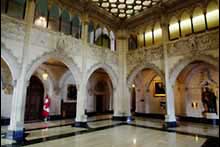
|
|

|
|

|
||||||
 |
MEMBERS OF
PARLIAMENT: A SNAPSHOT
Representing CanadiansMembers in ParliamentCanada's House of Commons is many things. It is a forum: a place where elected Members of Parliament publicly express the cares, concerns and priorities of the Canadians they represent. It is a legislature: a place where laws are proposed and refined. It is an institution: an administration created to support Members and the work they do on behalf of their constituents. Most importantly, it is a public arena in which democracy happens -actively, visibly and accountably. One of the most prominent expressions of democracy is a general election. In May 2004, the Thirty-seventh Parliament of Canada was dissolved and Canadians went to the polls in June to vote. Following the last national census, seven new ridings were created, raising the total number of seats in the House of Commons to 308. The House committed the necessary resources to ensure that all new Members received the support and services necessary to begin their parliamentary work. In October 2004, Canada's 308 elected Members convened in Ottawa for the opening of the country's Thirty-eighth Parliament. The Role Members PerformAs elected representatives, Members of Parliament generally belong to a political party and carry out their work within the party context. All parties maintain caucuses: groups of Members and Senators that discuss policy and strategy and conduct important research. While the structure and activities of caucuses vary party to party, each tends to meet weekly while the House of Commons is sitting, and most include sub-groups that focus on particular regions, issues or industries. As of March 31, 2005, 305 of Parliament's 308 Members belonged to one of four caucuses: Liberal Party, Conservative Party, Bloc Québécois or New Democratic Party. Two Members were independent of any party affiliation, and there was one vacancy. Beyond participation in their caucus, Members fulfill their roles by working in the Chamber and on committees; by serving their constituents; and by participating in international activities. Chamber ActivitiesIn the Chamber of the House of Commons, Members pose questions, debate and decide on bills and motions. They bring forward local, regional and national issues, and represent their constituents' views by presenting petitions and making statements. Committee WorkThe House of Commons delegates most of the detailed study of proposed legislation and the scrutiny of government policy and programs to its committees. Through participation in committees, Members consult Canadians and devote attention to matters of urgency and importance. Serving ConstituentsMembers work continuously to serve their constituents both in their home ridings and from their offices on Parliament Hill. Members assist constituents every day in a variety of ways-from supporting public initiatives in their home ridings to helping individuals access national programs and services. They also act as ombudsmen between their constituents and government departments, providing answers to questions and advocating solutions to problems when they arise. International ActivitiesMembers participate-at home and abroad-in bilateral and multilateral associations, interparliamentary groups, and international exchanges and conferences. Members also take part in delegations and exchanges to other nations and legislatures. Similarly, the House of Commons receives numerous heads of state, government leaders, parliamentarians and parliamentary officers. Members of Parliament: A SnapshotCanada's Members of Parliament are as diverse and multi-faceted as the people they serve and represent-politically, culturally, ethnically, religiously and professionally. Of the total number of Members of Parliament sitting at the time this report was prepared, 38 were born outside of Canada. Five Members were of Inuit, Métis and First Nation origin. Sixty-five Members were women-the greatest number of female Members in Canadian history. Members in the Thirty-eighth Parliament hailed from professions in a wide variety of fields: business, law, education, agriculture, defence, administration, journalism and many others. Canada's Members of Parliament embody the convictions and aspirations of several generations: again, at the time of this report, the average age of Members was 51. The youngest Member was 25; the oldest 73.
Sadly, one Member elected in the spring of 2004,
Lawrence O'Brien, passed away in December of that
year.
|
 
|
||||||||
